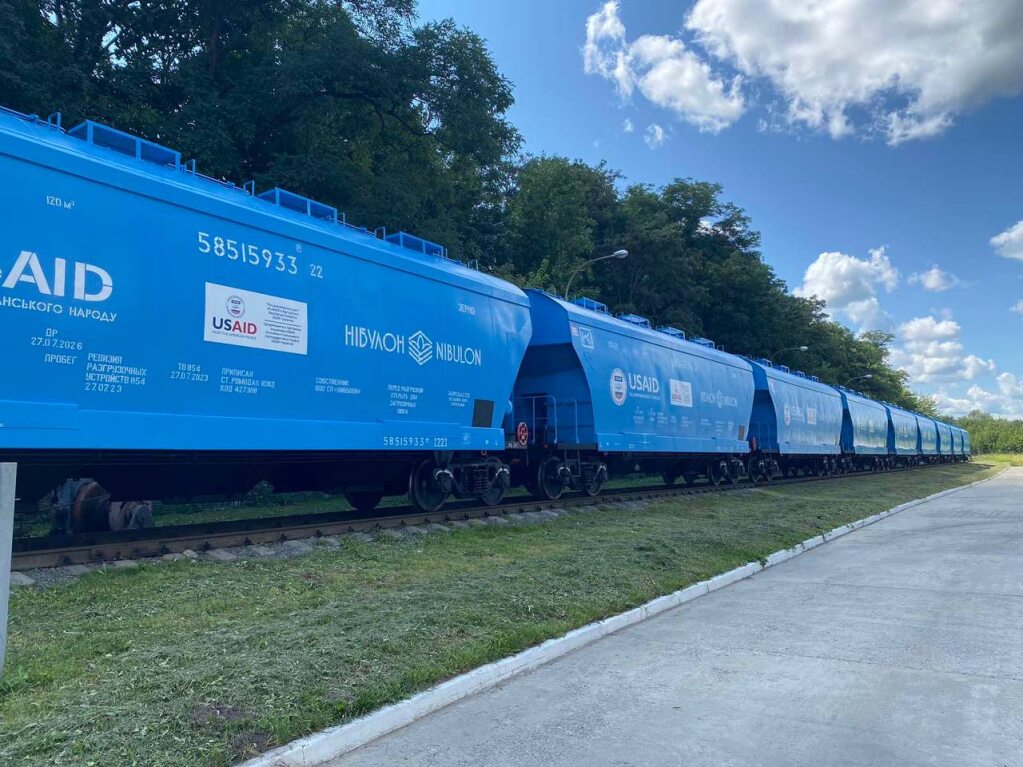In August 2023, USAID, through its Economic Resilience Activity (ERA), delivered 50 modern hopper wagons to Nibulon, Ukraine’s largest agricultural producer and grain export market leader. In over five months, these wagons have moved nearly 30,000 tons of Ukrainian grain from Nibulon’s blocked elevators to Danube seaports, which was then shipped to 25 countries. In total, the wagons made ten trips on different routes and covered 15,000 km.
Nibulon aims to connect local grain producers to global markets through a network of grain storage and handling terminals interlinked by a central logistics system. Before Russia’s full-scale invasion, Nibulon built 14 grain elevators on the Southern Buh and Dnipro rivers to revive inland river navigation and shipbuilding. However, in 2022, when Russia occupied Kherson Oblast and constantly shelled Mykolaiv, where Nibulon has its main transshipment terminal, nine grain elevators lost access to water and were cut off from logistics pathways. The remaining five were destroyed or ended up in occupied territory. The new logistics strategy relied on a complicated process: grain had to be trucked to the nearest railway station and then transferred onto wagons destined for export via the Izmail port in Odesa Oblast.
One of these blocked river ports, Zelenodolska, is in the village of Mar’yans’ke, which has a storage capacity of 76,000 tons. Before the war, farmers from the surrounding villages brought about 200,000 tons of grain annually to Mar’yans’ke. Since the beginning of the war, Zelenodolska port could not transport grain by barge, so they used trucks to deliver the harvest to the nearest Nibulon’s grain elevator.
N-I-K Farm in the Dnipropetrovsk Oblast, a family business founded in the early 2000s, was among those who sold their harvest to Nibulon and relied on the operation of Zelenodolska grain elevator. “Since 2010, we had been shipping almost all our grain to Nibulon,” recalls Mykhailo Poroslyy, N-I-K Farm founder. “Of course, we were afraid [when the war started] and felt insecure because the ports were blocked. What will happen to exports? Should we continue planting? If so, what exactly?” he added.
With USAID’s support, Nibulon could continue exporting grain by rebuilding its logistics routes and replacing barges with trucks and rail wagons, saving 350 jobs and eliminating additional expenditure for using Ukrainian Railway wagons.
“With the new wagons from USAID, we created an alternative route and transport grain by rail from the blocked river elevators to the Odesa and Danube ports. We can load up to 70 tons in a railcar, compared to 20 tons in a truck. Transporting grain by road is very expensive, and if we had continued to transport grain by truck, the cost to the company would have been higher. That would have affected the purchase price we offered farmers, or we would have had to close the terminals,” says Mykhailo Rizak, Nibulon’s Director of Government Relations.
With 50 wagons from USAID, Nibulon’s fleet has increased to a total of 212 wagons, an increase of 25%. In the future, the company plans to work with over 3,000 farms, export 200-300 thousand tons of grain per month, and contribute over 7% to Ukraine’s total exports next year.
Background: Assistance to agricultural producers and infrastructure companies is part of the Agriculture Resilience Initiative (AGRI) – Ukraine, implemented by the United States Agency for International Development (USAID). It aims to help Ukraine increase its capacity to produce, store, transport, and export grain.





